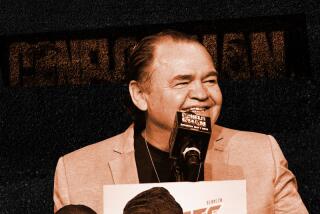Have Castanets, Will Travel to Van Nuys
- Share via
While flipping channels one afternoon, my former quarterback brother, Duffy, paused at an old Lawrence Welk flamenco clip. Captivated, he sought out lessons and was hooked. He said, “I smell like I did after football practice.”
Leaving his girlfriend and dog behind in Tennessee to move in with our parents in San Diego, he eventually found Roberto Amaral, a handsome, snowy-haired flamenco master who conducts class in a studio he built in the Valley. Duffy puts more than 700 miles a week on his VW to study bulerias, alegrias and seguiriyas. He’s been taking classes for six months, but it’s not unusual for Amaral’s students to have studied with him for 18 years. When electricity went out during the rains, Amaral lighted candles, and class continued by their glow.
Amaral is a native of East Los Angeles. His Brazilian father was a bandleader for Carmen Miranda, playing mandolin, violin and percussion in several of her Hollywood movies; his mother introduced him to flamenco music, but it was a live performance of Carmen Amaya that ignited Amaral’s love for the dance, at 12. He studied in Madrid and later toured internationally with Jose Greco.
In this bucolic Van Nuys neighborhood in the shadow of a high school and Bible warehouse, Amaral manipulates the rhythm of the 12-beat measure, warning, “You’re rushing it! You’re coming in on the one count. Start out in double time, then triplets for six, seven and eight!” After demonstrating the steps, he sits on a wooden box called the cajun, designed for flamenco. From his perch, Amaral beats each side of the cajun to create different sounds. He sings melodious laments, increasing the volume and pulse of the rhythm machine. He calls out, “It’s not ‘Riverdance,’ people!”
Flamenco is a dance of the earth, Gypsies and blues that originated in Spain. A young brother and sister from Santa Barbara--among the 20-plus students in the class-- dance in the front row, catching onto the stunningly complicated rhythms with seamless effort and beauty. Only 30 minutes earlier, they’d been doing their homework on the dressing room floor.
The guitarist plays bulerias as groups of dancers are helped to stay in compas (in time) by others who perform palmas (clapping). Several women in heavy skirts with ruffles, scarves, earrings and shawls spin in harmony in front of the wall-to-wall mirrors. Their hands move like birds, their feet stomp across the wood floor. One woman whispers, “When I dance, I feel alive.” This is a celebration, whirling to a fierce and relentless rhythm.
Wearing a black bandanna and clasping castanets, my brother mimics each new routine introduced, his concentration impenetrable. Duffy plans to leave for Spain shortly. I used to watch him play football. Now I watch him dance.--kerry madden-lunsford
More to Read
Sign up for The Wild
We’ll help you find the best places to hike, bike and run, as well as the perfect silent spots for meditation and yoga.
You may occasionally receive promotional content from the Los Angeles Times.






